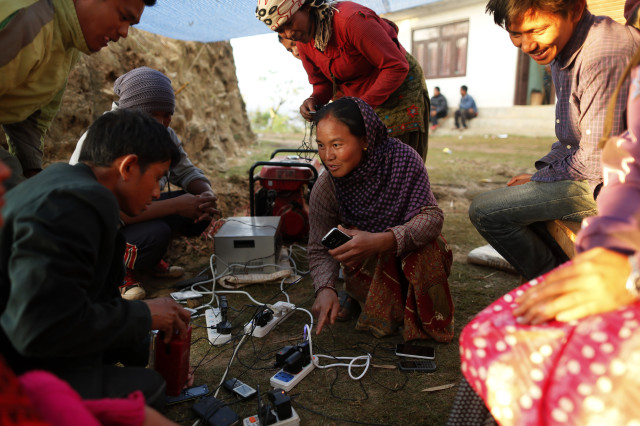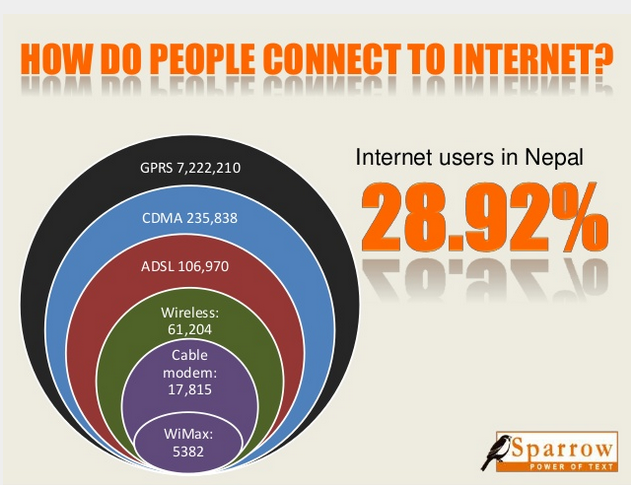
Young villagers charge their mobile phones from a generator in the destroyed village of Paslang near the epicenter of Saturday’s massive earthquake in the Gorkha District of Nepal, April 28, 2015. (AP)
Internet traffic to Nepal has slowly picked up since a massive April 25 earthquake killed more than 7,800 people and partially knocked out Internet connectivity, leaving people in the disaster zone unable to access web and mobile tools designed to help them connect with loved ones.
“They’re not back at pre-quake levels yet,” said David Belson, Editor of Akamai’s State of the Internet Report series in an interview. “But I think the growing traffic … is an indicator that connectivity is improving.”
He said the traffic pattern shows “continued connectivity in other parts of the country,” which suggests that the earthquake was centered in specific areas or that there were other “communication mechanisms” in place – “ways of getting that information around within the country, and then from there people can go to the Facebook and Google tools or email … someone directly.”
The 7.8 magnitude earthquake did not disconnect Nepal entirely from the global Internet. But when it struck, Internet traffic patterns to the country dropped “precipitously,” said Belson.
The connection to the outside world, however, does not help people along the so-called last mile – the end-point where fiber cables and mobile tower signals reach users.
Speaking with TECHtonics, Doug Madory, Director of Internet Analysis at Dyn Research in New Hampshire, said it is difficult to assess how much damage the access layers have sustained.
He said there are “a lot of mobile towers mounted hastily on rooftops that got knocked off due to shaking from the earthquake” and fiber optic lines “hastily run along telephone poles.”
“My understanding is that there are fiber cuts due to that. There are mobile towers [that] have been knocked down,” he continued. “And I think there [are] also a lot of issues with power right now. And so while there may be backup generators, those eventually run out of fuel and cause additional outages.”
Aftershocks and backup generator outages knocked out some of the smaller Internet service providers, while Nepal’s main mobile carriers were able to maintain connections to the outside world, albeit with interruptions.
Without power, “people are going to have a hard time maintaining connectivity,” Madory added.

A graphic from Nepal Telecom shows the various ways people in Nepal use to connect to the Internet.
Even before the earthquake, Nepal had limited Internet penetration. Estimates vary between 9-28 percent – a margin that is too large to be realistic, said Evert Bopp, Founder of Disaster Tech Lab.
“And I would put the actual figure somewhere in the middle,” he said in an email. “Quite often in developing countries, a physical line or a subscription is added as a user to the stats even if the service itself is of such a low quality that it’s unworkable.”
Depending on the level of damage inflicted on the country’s data systems, Belson said the infrastructure “is going to take a lot of time and resources and money to fix.”
“The amount of time it will take to recover to prior levels I think really depends on … a) the severity of the damage to the infrastructure and b) you know, sort of how it gets prioritized,” he said.
That means that food, shelter and sanitation top the priority list. While Internet connectivity is becoming a more critical need, allowing people to access web and mobile tools that can help them find loved ones or make sure they are safe, Belson said these are not the things that are “going to keep you alive.”
With the death toll rising daily as rescue teams sift through the rubble for any remaining survivors, there are more pressing issues at hand. And even after that, Madory expects the country to remain “in an impaired state for quite a while.”
“There’s so much destruction everywhere, like in Kathmandu … Where do you start?” Madory said.
